Effect of Climate on Residential Electricity Consumption: A Data-Driven Approach
Abstract
:1. Introduction
2. Materials and Methods
2.1. Research Design
2.2. Data
2.3. Methods
2.3.1. Distributional vs. Randomized Approach
2.3.2. Modeling the Climate–REC Functions
2.3.3. Model Interpretation
2.3.4. Addressing the Challenge of Multicollinearity
3. Results
3.1. Effect of Precipitation
3.2. Climate and Socioeconomic Effects
3.3. Different Climatic Effects Due to Urban–Rural Disparity
4. Discussion
5. Conclusions
Supplementary Materials
Author Contributions
Funding
Informed Consent Statement
Data Availability Statement
Conflicts of Interest
References
- IPCC. Contribution of Working Group I to the Sixth Assessment Report. In Climate Change 2021: The Physical Science Basis; IPCC: Geneva, Switzerland, 2021. [Google Scholar]
- Nordhaus, W.D. Revisiting the social cost of carbon. Proc. Natl. Acad. Sci. USA 2017, 114, 1518–1523. [Google Scholar] [CrossRef] [Green Version]
- Stern, N.; Stiglitz, J.E. The Social Cost of Carbon, Risk, Distribution, Market Failures: An Alternative Approach; National Bureau of Economic Research: Cambridge, MA, USA, 2021. [Google Scholar]
- Aldy, J.E.; Kotchen, M.J.; Stavins, R.N.; Stock, J.H. Keep climate policy focused on the social cost of carbon. Science 2021, 373, 850–852. [Google Scholar] [CrossRef]
- Steffen, W.; Richardson, K.; Rockström, J.; Schellnhuber, H.J.; Dube, O.P.; Dutreuil, S.; Lenton, T.M.; Lubchenco, J. The emergence and evolution of Earth System Science. Nat. Rev. Earth Environ. 2020, 1, 54–63. [Google Scholar] [CrossRef] [Green Version]
- CICC Global Institute. Carbon Neutrality Economics: Macro and Industry Trends under New Constraints; China CITIC Press: Beijing, China, 2021. [Google Scholar]
- Mideksa, T.K.; Kallbekken, S. The impact of climate change on the electricity market: A review. Energy Policy 2010, 38, 3579–3585. [Google Scholar] [CrossRef]
- Del Río, P.; Silvosa, A.C.; Gómez, G.I. Policies and design elements for the repowering of wind farms: A qualitative analysis of different options. Energy Policy 2011, 39, 1897–1908. [Google Scholar] [CrossRef]
- Himpler, S.; Madlener, R. Repowering of Wind Turbines: Economics and Optimal Timing; FCN: Aachen, Germany, 2011. [Google Scholar]
- De la Puente-Gil, Á.; González-Martínez, A.; Borge-Diez, D.; Martínez-Cabero, M.-Á.; de Simón-Martín, M. True power consumption labeling and mapping of the health system of the Castilla y León region in Spain by clustering techniques. Energy Procedia 2019, 157, 1164–1181. [Google Scholar] [CrossRef]
- Li, D.H.; Yang, L.; Lam, J.C. Impact of climate change on energy use in the built environment in different climate zones–A review. Energy 2012, 42, 103–112. [Google Scholar] [CrossRef]
- Auffhammer, M.; Baylis, P.; Hausman, C.H. Climate change is projected to have severe impacts on the frequency and intensity of peak electricity demand across the United States. Proc. Natl. Acad. Sci. USA 2017, 114, 1886–1891. [Google Scholar] [CrossRef] [Green Version]
- Auffhammer, M.; Mansur, E.T. Measuring climatic impacts on energy consumption: A review of the empirical literature. Energy Econ. 2014, 46, 522–530. [Google Scholar] [CrossRef] [Green Version]
- Deschênes, O.; Greenstone, M. Climate change, mortality, and adaptation: Evidence from annual fluctuations in weather in the US. Am. Econ. J. Appl. Econ. 2011, 3, 152–185. [Google Scholar] [CrossRef]
- Waite, M.; Cohen, E.; Torbey, H.; Piccirilli, M.; Tian, Y.; Modi, V. Global trends in urban electricity demands for cooling and heating. Energy 2017, 127, 786–802. [Google Scholar] [CrossRef] [Green Version]
- Li, Y.; Pizer, W.A.; Wu, L. Climate change and residential electricity consumption in the Yangtze River Delta, China. Proc. Natl. Acad. Sci. USA 2019, 116, 472–477. [Google Scholar] [CrossRef] [Green Version]
- Auffhammer, M. Climate Adaptive Response Estimation: Short and Long Run Impacts of Climate Change on Residential Electricity and Natural Gas Consumption Using Big Data; National Bureau of Economic Research: Cambridge, MA, USA, 2018. [Google Scholar]
- De la Puente-Gil, Á.; González-Martínez, A.; Borge-Diez, D.; Blanes-Peiró, J.J.; de Simón-Martín, M. Electrical Consumption Profile Clusterization: Spanish Castilla y León Regional Health Services Building Stock as a Case Study. Environments 2018, 5, 133. [Google Scholar] [CrossRef] [Green Version]
- Rezaei, K.; Pradhan, B.; Vadiati, M.; Nadiri, A.A. Suspended sediment load prediction using artificial intelligence techniques: Comparison between four state-of-the-art artificial neural network techniques. Arab. J. Geosci. 2021, 14, 215. [Google Scholar] [CrossRef]
- Eskandari, E.; Mohammadzadeh, H.; Nassery, H.; Vadiati, M.; Zadeh, A.M.; Kisi, O. Delineation of isotopic and hydrochemical evolution of karstic aquifers with different cluster-based (HCA, KM, FCM and GKM) methods. J. Hydrol. 2022, 609, 127706. [Google Scholar] [CrossRef]
- Strahler, A.H. Introducing Physical Geography; Wiley: New York, NY, USA, 2011. [Google Scholar]
- Wenz, L.; Levermann, A.; Auffhammer, M. North–south polarization of European electricity consumption under future warming. Proc. Natl. Acad. Sci. USA 2017, 114, E7910–E7918. [Google Scholar] [CrossRef] [Green Version]
- Eskeland, G.S.; Mideksa, T.K. Electricity demand in a changing climate. Mitig. Adapt. Strateg. Glob. Chang. 2010, 15, 877–897. [Google Scholar] [CrossRef]
- Auffhammer, M. Cooling China: The weather dependence of air conditioner adoption. Front. Econ. China 2014, 9, 70–84. [Google Scholar]
- Davis, L.W.; Gertler, P.J. Contribution of air conditioning adoption to future energy use under global warming. Proc. Natl. Acad. Sci. USA 2015, 112, 5962–5967. [Google Scholar] [CrossRef] [Green Version]
- Auffhammer, M.; Aroonruengsawat, A. Simulating the impacts of climate change, prices and population on California’s residential electricity consumption. Clim. Chang. 2011, 109, 191–210. [Google Scholar] [CrossRef]
- Papakostas, K.; Mavromatis, T.; Kyriakis, N. Impact of the ambient temperature rise on the energy consumption for heating and cooling in residential buildings of Greece. Renew. Energy 2010, 35, 1376–1379. [Google Scholar] [CrossRef]
- Jylhä, K.; Jokisalo, J.; Ruosteenoja, K.; Pilli-Sihvola, K.; Kalamees, T.; Seitola, T.; Mäkelä, H.M.; Hyvönen, R.; Laapas, M.; Drebs, A. Energy demand for the heating and cooling of residential houses in Finland in a changing climate. Energy Build. 2015, 99, 104–116. [Google Scholar] [CrossRef]
- Zhang, M.; Zhang, K.; Hu, W.; Zhu, B.; Wang, P.; Wei, Y.-M. Exploring the climatic impacts on residential electricity consumption in Jiangsu, China. Energy Policy 2020, 140, 111398. [Google Scholar] [CrossRef]
- Cohen, J.; Screen, J.A.; Furtado, J.; Barlow, M.; Whittleston, D.; Coumou, D.; A Francis, J.; Dethloff, K.; Entekhabi, D.; E Overland, J.; et al. Recent Arctic amplification and extreme mid-latitude weather. Nat. Geosci. 2014, 7, 627–637. [Google Scholar] [CrossRef] [Green Version]
- Zhang, W.; Furtado, K.; Wu, P.; Zhou, T.; Chadwick, R.; Marzin, C.; Rostron, J.; Sexton, D. Increasing precipitation variability on daily-to-multiyear time scales in a warmer world. Sci. Adv. 2021, 7, eabf8021. [Google Scholar] [CrossRef]
- Busby, J.W.; Baker, K.; Bazilian, M.D.; Gilbert, A.Q.; Grubert, E.; Rai, V.; Rhodes, J.D.; Shidore, S.; Smith, C.A.; Webber, M.E. Cascading risks: Understanding the 2021 winter blackout in Texas. Energy Res. Soc. Sci. 2021, 77, 102106. [Google Scholar] [CrossRef]
- Zheng, X. Power Utilities Asked to Ensure Proper Supply. Available online: https://global.chinadaily.com.cn/a/202012/19/WS5fdd5583a31024ad0ba9cc79.html (accessed on 15 April 2022).
- Aljazeera. Huge US Winter Storm Leaves More than 330,000 without Power. Available online: https://www.aljazeera.com/news/2022/2/4/huge-us-winter-storm-leaves-more-than-330000-without-power (accessed on 15 April 2022).
- Chen, G.; Zhu, Y.; Wiedmann, T.; Yao, L.; Xu, L.; Wang, Y. Urban-rural disparities of household energy requirements and influence factors in China: Classification tree models. Appl. Energy 2019, 250, 1321–1335. [Google Scholar] [CrossRef]
- Nie, H.-G.; Kemp, R.; Xu, J.-H.; Vasseur, V.; Fan, Y. Drivers of urban and rural residential energy consumption in China from the perspectives of climate and economic effects. J. Clean. Prod. 2018, 172, 2954–2963. [Google Scholar] [CrossRef]
- Yao, T. Tackling on environmental changes in Tibetan Plateau with focus on water, ecosystem and adaptation. Sci. Bull. 2019, 64, 417. [Google Scholar] [CrossRef] [Green Version]
- Yao, T.; Xue, Y.; Chen, D.; Chen, F.; Thompson, L.; Cui, P.; Koike, T.; Lau, W.K.-M.; Lettenmaier, D.; Mosbrugger, V.; et al. Recent Third Pole’s rapid warming accompanies cryospheric melt and water cycle intensification and interactions between monsoon and environment: Multidisciplinary approach with observations, modeling, and analysis. Bull. Am. Meteorol. Soc. 2019, 100, 423–444. [Google Scholar] [CrossRef]
- Frederiks, E.R.; Stenner, K.; Hobman, E.V. The socio-demographic and psychological predictors of residential energy consumption: A comprehensive review. Energies 2015, 8, 573–609. [Google Scholar] [CrossRef] [Green Version]
- Fan, J.-L.; Zhang, Y.-J.; Wang, B. The impact of urbanization on residential energy consumption in China: An aggregated and disaggregated analysis. Renew. Sustain. Energy Rev. 2017, 75, 220–233. [Google Scholar] [CrossRef]
- Zheng, S.; Huang, G.; Zhou, X.; Zhu, X. Climate-change impacts on electricity demands at a metropolitan scale: A case study of Guangzhou, China. Appl. Energy 2020, 261, 114295. [Google Scholar] [CrossRef]
- Yao, A.C.-C. Probabilistic computations: Toward a unified measure of complexity. In Proceedings of the 18th Annual Symposium on Foundations of Computer Science (sfcs 1977), Providence, RI, USA, 31 October–2 November 1977; pp. 222–227. [Google Scholar]
- Breiman, L. Statistical modeling: The two cultures (with comments and a rejoinder by the author). Stat. Sci. 2001, 16, 199–231. [Google Scholar] [CrossRef]
- Shouzhang, P. 1-km Monthly Mean Temperature Dataset for China (1901–2017); National Tibetan Plateau/Third Pole Environment Data Center: Beijing, China, 2019. [Google Scholar] [CrossRef]
- Shouzhang, P. 1-km Monthly Precipitation Dataset for China (1901–2017); National Tibetan Plateau/Third Pole Environment Data Center: Beijing, China, 2020. [Google Scholar] [CrossRef]
- Brownlee, J. Machine Learning Mastery with Python; Machine Learning Mastery. 2016, Volume 527, pp. 100–120. Available online: https://books.google.com.hk/books?hl=en&lr=&id=BgmqDwAAQBAJ&oi=fnd&pg=PP1&dq=Machine+Learning+Mastery+with+Python&ots=frmYXAqM4V&sig=JKLaQWQuS8QRJODNyQhS_dWmYi0&redir_esc=y&hl=zh-CN&sourceid=cndr#v=onepage&q=Machine%20Learning%20Mastery%20with%20Python&f=false (accessed on 15 April 2022).
- Altman, N.S. An introduction to kernel and nearest-neighbor nonparametric regression. Am. Stat. 1992, 46, 175–185. [Google Scholar]
- Cortes, C.; Vapnik, V. Support-vector networks. Mach. Learn. 1995, 20, 273–297. [Google Scholar] [CrossRef]
- Breiman, L.; Friedman, J.; Olshen, R.; Stone, C. Classification Regression Trees; Routledge: England, UK, 2017. [Google Scholar]
- Friedman, J.; Hastie, T.; Tibshirani, R. The Elements of Statistical Learning; Springer: New York, NY, USA, 2001; Volume 1. [Google Scholar]
- Ho, T.K. Random decision forests. In Proceedings of the 3rd international Conference on Document Analysis and Recognition, Montreal, QC, Canada, 14–16 August 1995; pp. 278–282. [Google Scholar]
- Geurts, P.; Ernst, D.; Wehenkel, L. Extremely randomized trees. Mach. Learn. 2006, 63, 3–42. [Google Scholar] [CrossRef] [Green Version]
- Kégl, B. The return of AdaBoost. MH: Multi-class Hamming trees. arXiv 2013, arXiv:1312.6086. [Google Scholar] [CrossRef]
- Mason, L.; Baxter, J.; Bartlett, P.; Frean, M. Boosting algorithms as gradient descent. Adv. Neural Inf. Processing Syst. 1999, 12, 512–518. [Google Scholar]
- Friedman, J.H. Greedy function approximation: A gradient boosting machine. Ann. Stat. 2001, 29, 1189–1232. [Google Scholar] [CrossRef]
- Pedregosa, F.; Varoquaux, G.; Gramfort, A.; Michel, V.; Thirion, B.; Grisel, O.; Blondel, M.; Prettenhofer, P.; Weiss, R.; Dubourg, V. Scikit-learn: Machine learning in Python. J. Mach. Learn. Res. 2011, 12, 2825–2830. [Google Scholar]
- Azodi, C.B.; Tang, J.; Shiu, S.-H. Opening the Black Box: Interpretable machine learning for geneticists. Trends Genet. 2020, 36, 442–455. [Google Scholar] [CrossRef]
- Friedman, J.H.; Meulman, J.J. Multiple additive regression trees with application in epidemiology. Stat. Med. 2003, 22, 1365–1381. [Google Scholar] [CrossRef]
- Molnar, C. Interpretable Machine Learning; Ruboss Technology Corporation: Victoria, BC, Canada, 2020. [Google Scholar]
- Strobl, C.; Boulesteix, A.-L.; Zeileis, A.; Hothorn, T. Bias in random forest variable importance measures: Illustrations, sources and a solution. BMC Bioinform. 2007, 8, 25. [Google Scholar] [CrossRef] [Green Version]
- Goldstein, A.; Kapelner, A.; Bleich, J.; Pitkin, E. Peeking inside the black box: Visualizing statistical learning with plots of individual conditional expectation. J. Comput. Graph. Stat. 2015, 24, 44–65. [Google Scholar] [CrossRef]
- Zhao, Q.; Hastie, T. Causal interpretations of black-box models. J. Bus. Econ. Stat. 2019, 39, 272–281. [Google Scholar] [CrossRef]
- Mehdiyev, N.; Fettke, P. Prescriptive process analytics with deep learning and explainable artificial intelligence. In Proceedings of the 28th European Conference on Information Systems (ECIS), Online AIS Conference, 15–17 June 2020. [Google Scholar]
- Ronaghan, S. The Mathematics of Decision Trees, Random Forest and Feature Importance in Scikit-learn and Spark. Available online: https://towardsdatascience.com/the-mathematics-of-decision-trees-random-forest-and-feature-importance-in-scikit-learn-and-spark-f2861df67e3 (accessed on 15 April 2022).
- Chong, I.-G.; Jun, C.-H. Performance of some variable selection methods when multicollinearity is present. Chemom. Intell. Lab. Syst. 2005, 78, 103–112. [Google Scholar] [CrossRef]
- Du, K.; Yu, Y.; Wei, C. Climatic impact on China’s residential electricity consumption: Does the income level matter? China Econ. Rev. 2020, 63, 101520. [Google Scholar] [CrossRef]
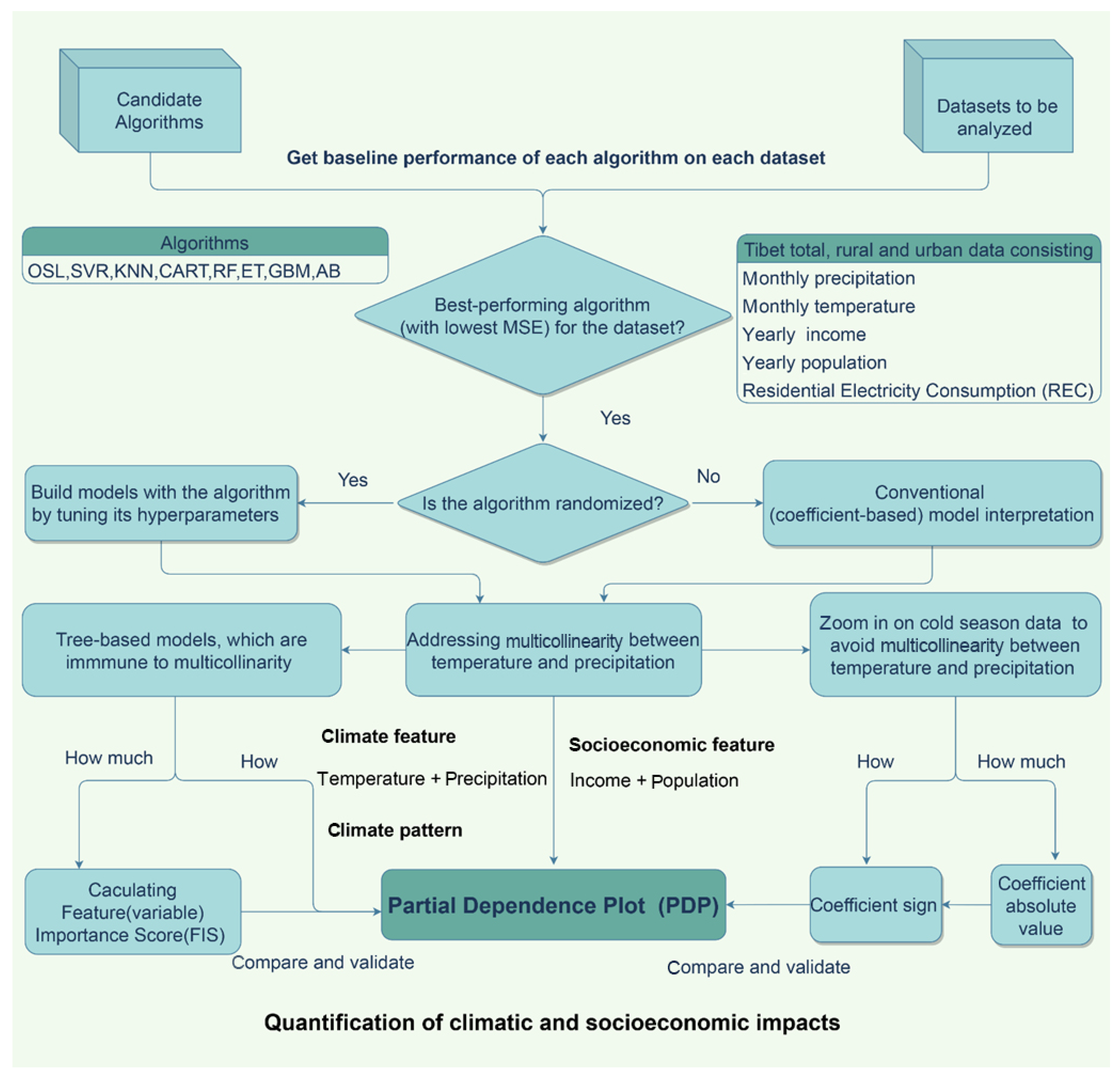

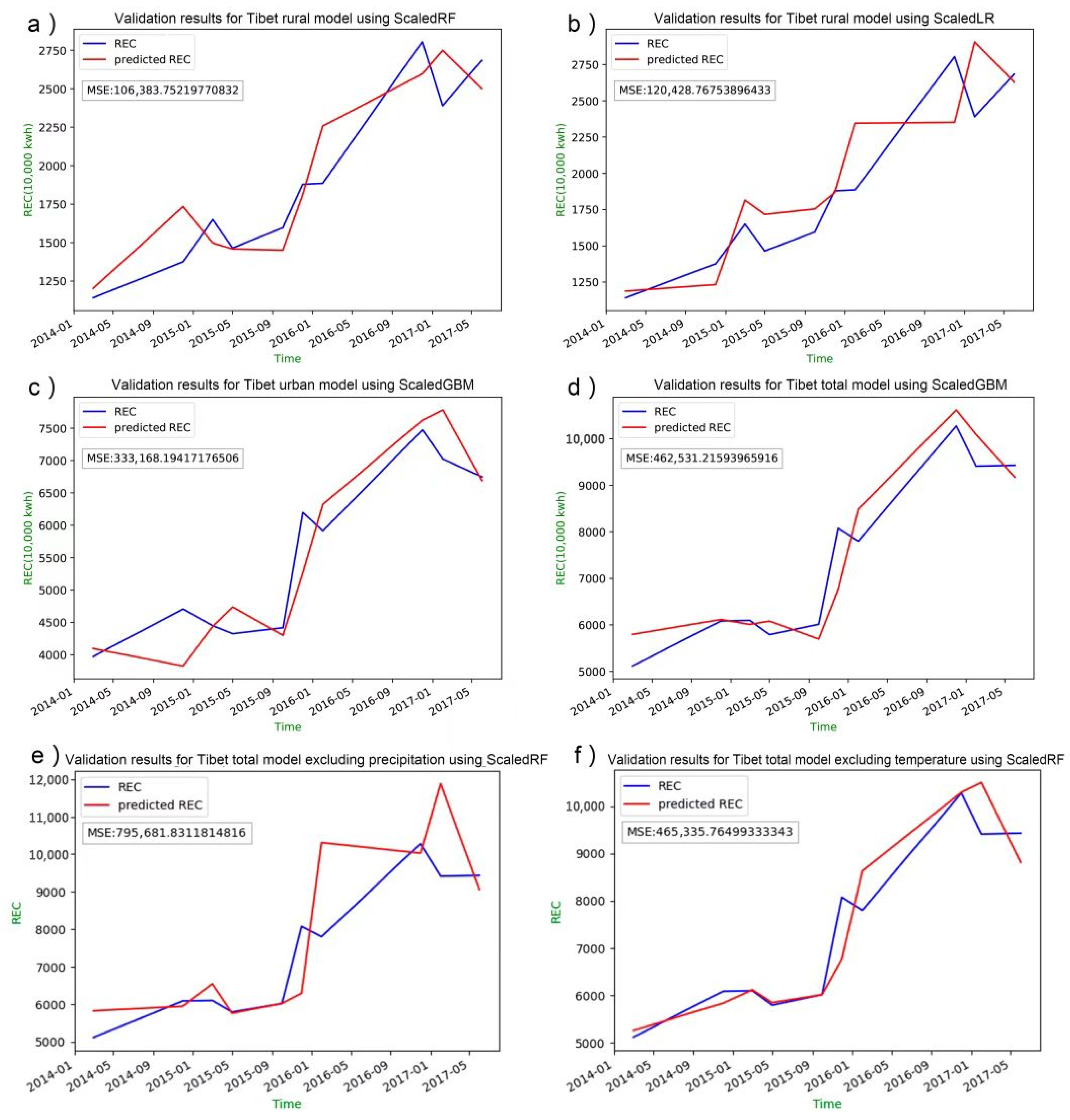
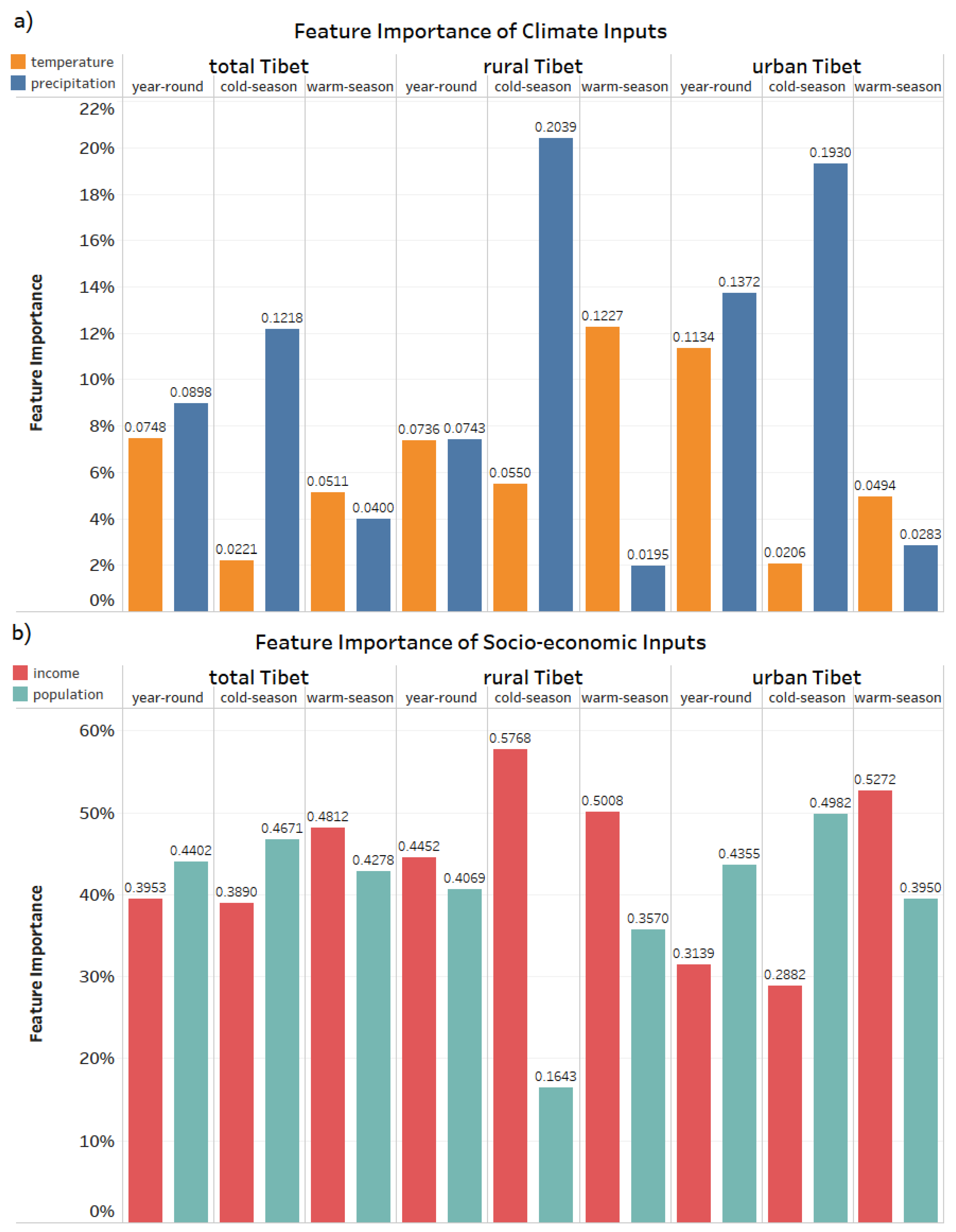
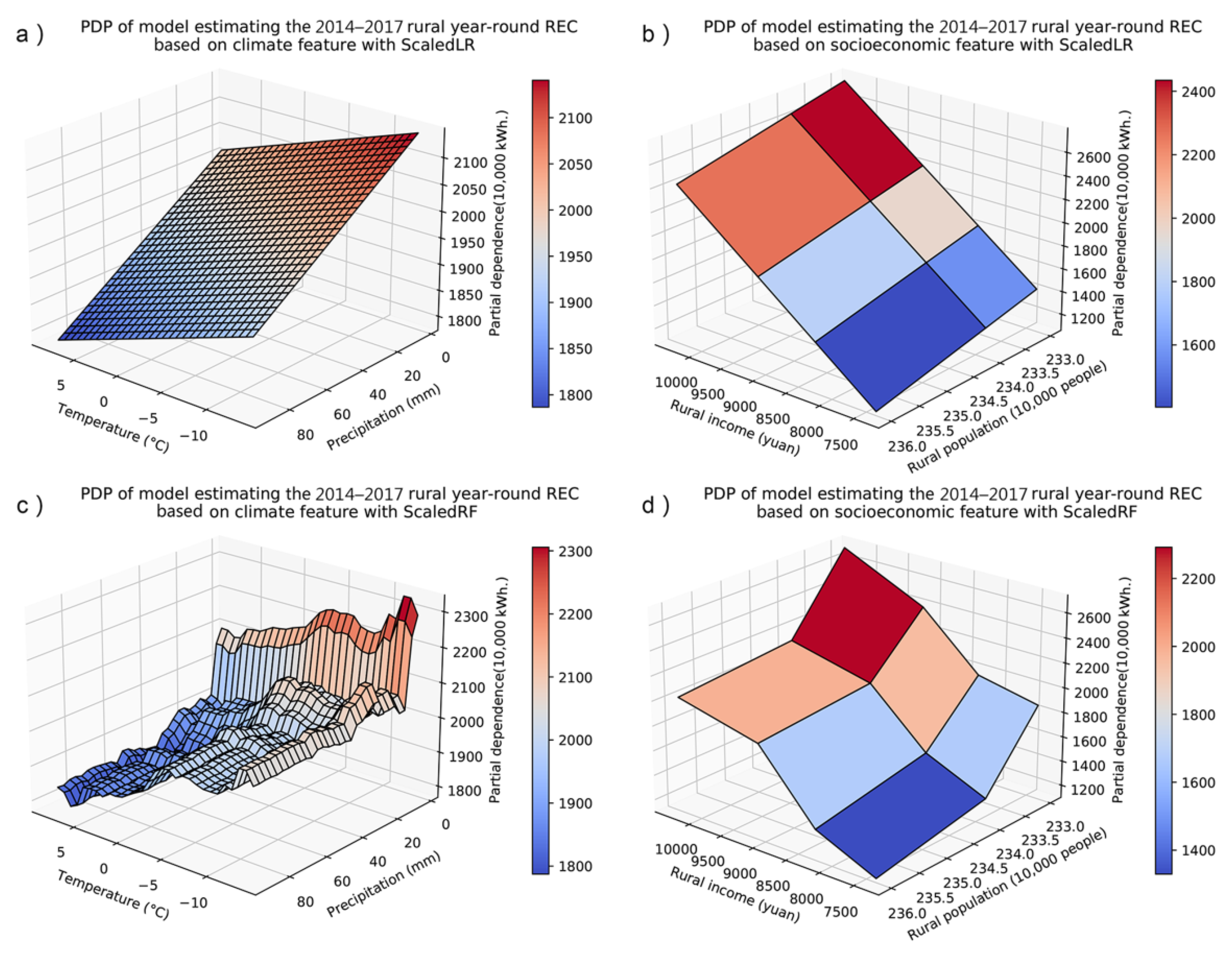
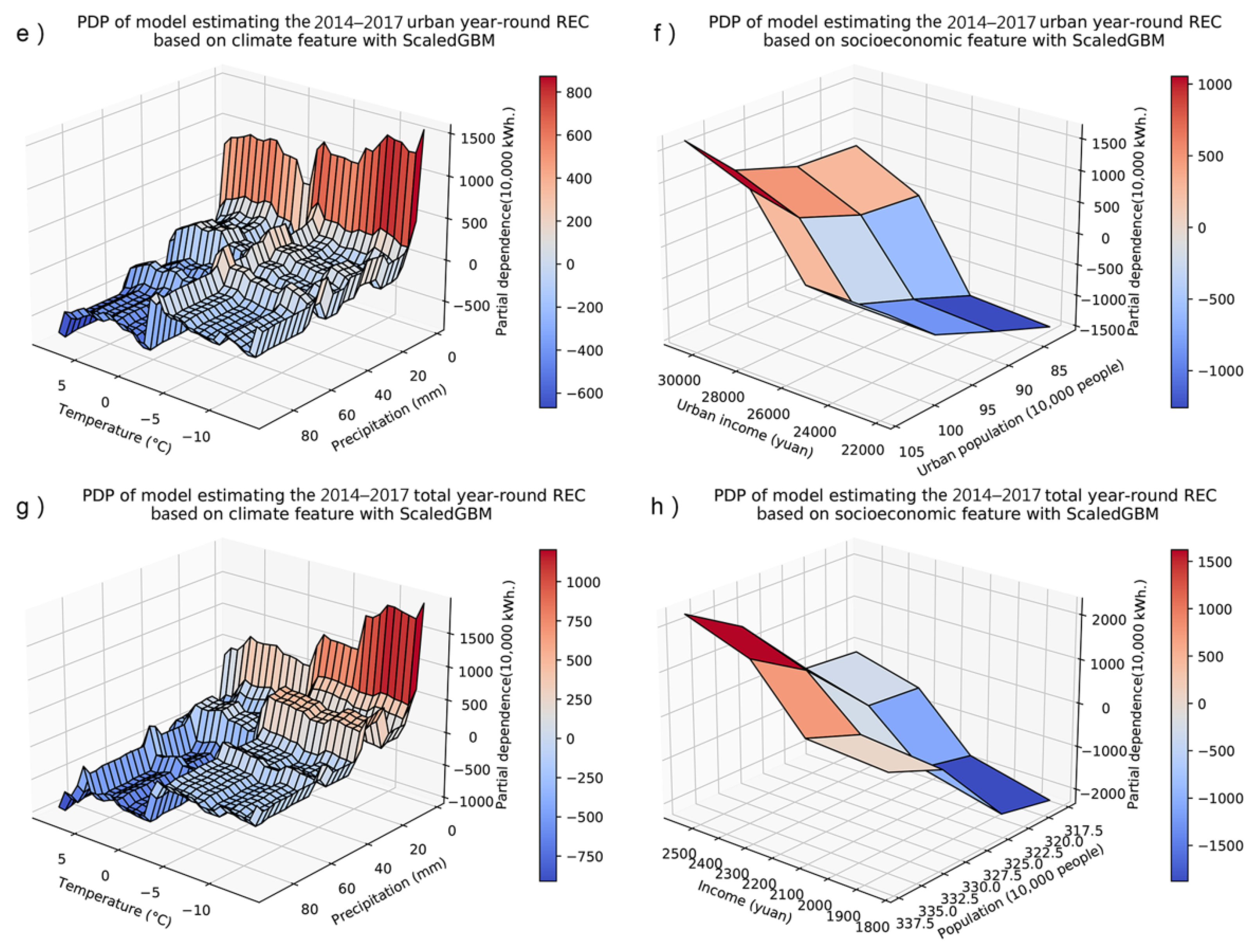

| Pair of Variables | Season | Type | Spearman’s Correlation Coefficients | Highly Correlated (>0.5) |
|---|---|---|---|---|
| Temperature-Precipitation | Year-round | - | 0.89 | Yes |
| Cold season | - | 0.5 | No | |
| Warm season | - | 0.81 | Yes | |
| Income-Population | - | Total | 1 | Yes |
| - | Rural | −0.95 | Yes | |
| - | Urban | 1 | Yes |
| Data | Response Variable | R2 | Coefficient | Predictor Variables | p |
|---|---|---|---|---|---|
| Tibet Rural 2014–2017 (year-round) | REC | 80.8% | −38.7626 | Temperature | 0.698 |
| −71.6497 | Precipitation | 0.462 | |||
| 600.9989 | Income | 0.000 | |||
| −207.8950 | Population | 0.175 | |||
| Tibet Rural 2014–2017 (cold season) | REC | 74.5% | 121.7221 | Temperature | 0.479 |
| −404.0049 | Precipitation | 0.285 | |||
| 689.3523 | Income | 0.001 | |||
| 1.0650 | Population | 0.996 | |||
| Tibet Rural 2014–2017 (warm season) | REC | 92.7% | −80.0322 | Temperature | 0.757 |
| 26.1458 | Precipitation | 0.809 | |||
| 462.7637 | Income | 0.002 | |||
| −507.2098 | Population | 0.007 |
Publisher’s Note: MDPI stays neutral with regard to jurisdictional claims in published maps and institutional affiliations. |
© 2022 by the authors. Licensee MDPI, Basel, Switzerland. This article is an open access article distributed under the terms and conditions of the Creative Commons Attribution (CC BY) license (https://creativecommons.org/licenses/by/4.0/).
Share and Cite
Xia, C.; Yao, T.; Wang, W.; Hu, W. Effect of Climate on Residential Electricity Consumption: A Data-Driven Approach. Energies 2022, 15, 3355. https://doi.org/10.3390/en15093355
Xia C, Yao T, Wang W, Hu W. Effect of Climate on Residential Electricity Consumption: A Data-Driven Approach. Energies. 2022; 15(9):3355. https://doi.org/10.3390/en15093355
Chicago/Turabian StyleXia, Cuihui, Tandong Yao, Weicai Wang, and Wentao Hu. 2022. "Effect of Climate on Residential Electricity Consumption: A Data-Driven Approach" Energies 15, no. 9: 3355. https://doi.org/10.3390/en15093355
APA StyleXia, C., Yao, T., Wang, W., & Hu, W. (2022). Effect of Climate on Residential Electricity Consumption: A Data-Driven Approach. Energies, 15(9), 3355. https://doi.org/10.3390/en15093355






